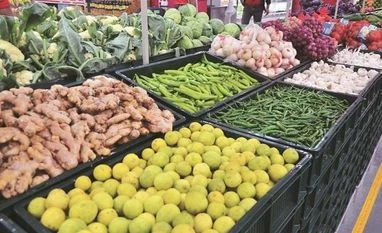The retail price inflation rate inched down to 3.15 per cent in July against 3.18 per cent in the previous month, owing to a fall in energy prices, justifying the Reserve Bank of India’s (RBI’s) monetary policy committee’s move to cut the policy rate for the fourth consecutive time. This was the first time in six months that the inflation rate dipped.
The marginal dip was despite the food inflation rate rising slightly to 2.36 per cent from 2.25 per cent during this period, official data released on Tuesday showed.
The inflation in vegetables came down to 2.82 per cent from 4.66 per cent.
The rate of price rise in pulses and products moved up to 6.82 per cent, against 5.68 per cent.
Prices of non-vegetarian items, such as meat and fish, remained elevated as inflation there rose a bit to 9.05 per cent from 9.01 per cent. However, eggs saw a moderate inflation that came down to 0.57 per cent against 1.62 per cent.
Economists cautioned against wrong interpretation of food inflation.
“The incoming trends in food prices need to be cautiously watched, following the recent flooding in some states, rising vegetable prices and continued lag in kharif sowing. Moreover, an unfavourable base effect is likely to contribute to a hardening of food inflation in the ongoing quarter,” said Aditi Nayar, principal economist at India Ratings.
CARE Ratings Chief Economist Madan Sabnavis said going forward, seasonal factors could exert upward pressures on food prices. “The progress and dispersion of rainfall could also have a bearing on price levels. In addition, the lower base of a year ago could push up the overall inflation readings,” he said.
He said vegetable prices moderated with the arrival of new crops, while the contraction in fruit price index during the month can be ascribed to the favourable statistical base effect.
Fuel and light saw deflation in July at 0.36 per cent against 2.32 per cent inflation in the previous month.
Leaving these two items — food and fuel — the remaining core inflation saw an uptick to 4.4 per cent against 4.3 per cent.
“The core-CPI inflation may not ease meaningfully from the current levels, in our view, as demand for services will remain sticky even during an economic slowdown,” Nayar said.
Sabnavis said there had been a reversal in the easing of non-food and non-fuel inflation or core inflation of the last six months.
Among services, inflation in health, a category which saw a spurt in inflation in recent times, fell to 7.88 per cent from 8.22 per cent.
Also, inflation in education dropped to 6.36 per cent from 6.79 per cent.
The rate of price rise in housing, which is basically rent in the urban areas, increased marginally to 4.87 per cent from 4.84 per cent.
Also, inflation in recreation and amusement rose to 5.48 per cent from 5.20 per cent.
So far, as overall inflation is concerned, Nayar expected it to inch up in the next two months, while remaining below the MPC’s target of 4 per cent during the second quarter of the current financial year.
Even then, economists are divided whether MPC would cut the repo rate one more time at its meeting in October.
“The CPI inflation trajectory may allow for a 15 bps rate cut in October, after monsoon-related uncertainties get resolved, especially if crude oil and other commodity prices remain relatively soft,” Nayar said.
However, Sabnavis said the rise in core inflation, if it persists, could be a concern and could pose a challenge to the RBI in easing its monetary policy.

Unlock 30+ premium stories daily hand-picked by our editors, across devices on browser and app.
Pick your favourite companies, get a daily email with all news updates on them.
Full access to our intuitive epaper - clip, save, share articles from any device; newspaper archives from 2006.
Preferential invites to Business Standard events.
Curated newsletters on markets, personal finance, policy & politics, start-ups, technology, and more.



)